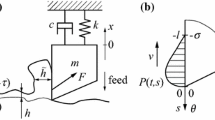Abstract
The prediction of chatter vibration is influenced by many known complex phenomena and is uncertain. We present a new effect that can significantly change the stability properties of cutting processes. It is shown that the microscopic environment of chip formation can have a large effect on its macroscopic properties. In this work, a combined model of the surface regeneration effect and chip formation is used to predict the stability of turning processes. In a chip segmentation sub-model, the primary shear zone is described with a corresponding material model along layers together with the thermodynamic behavior. The surface regeneration is modeled by the time-delayed differential equation. Numerical simulations show that the time scale of a chip segmentation model is significantly smaller than the time scale of the turning process; therefore, averaging methods can be used. Chip segmentation can decrease the average shear force leading to decreased cutting coefficients because of the non-linear effects. A proper linearization of the equation of motion leads to an improved description of the cutting coefficients. It is shown that chip segmentation may significantly increase the stable domains in the stability charts; furthermore, by selecting proper parameters, unbounded stability domains can be reached.
















Similar content being viewed by others
Abbreviations
- \(a\), \(b\), \(C\) :
-
Constants in the constitutive equation
- \(c\) :
-
Heat capacity, J/(kg·K)
- \(E\) :
-
Modulus of elasticity, MPa
- \(h_{0}\) :
-
Initial chip thickness, m
- \(K\) :
-
Time scale of chip formation, s
- \(L\) :
-
Acting length of normal stress, m
- \(r\) :
-
Energy ratio
- \(T_{i}\) :
-
Temperature of shear zone band i, K
- \(T_{\text{w}}\) :
-
Temperature of workpiece, K
- \(\tilde{t}\) :
-
Dimensionless time of chip formation
- \(\hat{t}\) :
-
Dimensionless time of turning
- \(v\) :
-
Cutting speed, m/s
- \(\delta\) :
-
Thickness of deformation layer, m
- \(\gamma_{i}\) :
-
Shear strain in shear zone band i
- \(\varPhi\) :
-
Angle of shear plane, rad
- \(\varOmega\) :
-
Angular velocity of workpiece, rad/s
- \(\omega_{\text{n}}\) :
-
Natural frequency of machine-tool system, rad/s
- \(\rho\) :
-
Density, kg/m3
- \(\kappa\) :
-
Relative damping
- \(\tau_{\varPhi }\) :
-
Shear stress in case of continuous chip formation, N/m2
- \(\xi\), \(\eta\), \(\zeta\) :
-
Dimensionless parameters of chip formation
References
Tobias SA, Fishwick W (1958) Theory of regenerative machine tool chatter. Engineer 205(199–203):238–239
Tobias SA (1965) Machine tool vibration. Blackie and Son Ltd., Glasgow
Altintas Y (2012) Manufacturing automation: metal cutting mechanics. Machine tool vibrations, and CNC design. Cambridge University Press, Cambridge
Munoa J, Beudaert X, Dombovari Z et al (2016) Chatter suppression techniques in metal cutting. CIRP Ann Manuf Technol 65(2):785–808
Tlusty J, Polacek M (1963) The stability of the machine tool against self-exited vibration in machining. In: Proceedings of the international research in production engineering conference, ASME Press, Pittsburgh, pp 465–474
Stepan G (1989) Retarded dynamical systems: stability and characteristic functions. Longman Scientific & Technical, New York. ISBN 0-582-03932-0
Hajdu D, Insperger T, Stepan G (2017) Robust stability analysis of machining operations. Int J Adv Manuf Technol 88(1):45–54
Sykora HT, Bachrathy D, Stepan G (2017) A theoretical investigation of the effect of the stochasticity in the material properties on the chatter detection during turning. In: Proceedings of the ASME 2017 conference on mechanical vibration and noise, August 6–9
Stepan G, Dombovari Z, Munoa J (2011) Identification of cutting force characteristics based on chatter experiments. CIRP Ann Manuf Technol 60(1):113–116
Altintas Y, Eynian M, Onozuka H (2008) Identification of dynamic cutting force coefficients and chatter stability with process damping. CIRP Ann Manuf Technol 57(1):371–374
Budak E, Tunc LT (2010) Identification and modeling of process damping in turning and milling using a new approach. CIRP Ann Manuf Technol 59(1):403–408
Molnár TG, Insperger T, Bachrathy D et al (2017) Extension of process damping to milling with low radial immersion. Int J Adv Manuf Technol 89:2545–2556
Bachrathy D, Stepan G (2009) Bistable parameter region caused by velocity dependent chip thickness in milling process. In: 12th CIRP conference on modelling of machining operations, San Sebastian, Spain
Cedergren S, Frangoudis C, Archenti A et al (2016) Influence of work material microstructure on vibrations when machining cast Ti-6Al-4V. Int J Adv Manuf Technol 84:2277–2291
Özlü E, Budak E (2007) Analytical modeling of chatter stability in turning and boring operations—Part II: experimental verification. J Manuf Sci Eng 129:733–739
Dombovari Z, Munoa J, Kuske R et al (2017) Non-smooth torus to identify domain of attraction of stable milling processes. In: 9th European nonlinear dynamics conference (ENOC 2017), Budapest, Hungary
Pálmai Z (2006) Chaotic phenomena induced by the fast plastic deformation of metals during cutting. ASME J Appl Mech 73:240–245
Pálmai Z, Csernák G (2009) Chip formation as an oscillator during the turning process. J Sound Vib 326(3–5):809–820
Csernák G, Pálmai Z (2009) Exploration of the chaotic phenomena induced by fast plastic deformation of metals. Int J Adv Manuf Technol 40(3):270–276
Pawade RS, Joshi SS (2011) Mechanism of chip formation in high-speed turning of Inconel 718. Mach Sci Technol 15(1):132–152
Eynian M, Altintas Y (2009) Chatter stability of general turning operations with process damping. J Manuf Sci Eng 131(4):041005
Trent EM, Wright PK (2000) Metal cutting. Butterworth-Heinemann, Boston
Pavliotis GA, Stuart AM (2008) Multiscale methods: averaging and homogenization. Springer, New York
Bachrathy D, Stepan G (2012) Bisection method in higher dimensions and the efficiency number. Period Polytech Mech Eng 56(2):81–86
Acknowledgements
This research study received funding from the European Research Council under the European Union’s Seventh Framework Programme (FP7/2007–2013) ERC advanced grant agreement (Grant No. 340889) and was supported by the Hungarian Scientific Research Fund—OTKA PD-112983 and the Janos Bolyai Research Scholarship of the Hungarian Academy of Sciences.
Author information
Authors and Affiliations
Corresponding author
Rights and permissions
About this article
Cite this article
Gyebrószki, G., Bachrathy, D., Csernák, G. et al. Stability of turning processes for periodic chip formation. Adv. Manuf. 6, 345–353 (2018). https://doi.org/10.1007/s40436-018-0229-6
Received:
Accepted:
Published:
Issue Date:
DOI: https://doi.org/10.1007/s40436-018-0229-6



